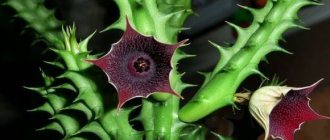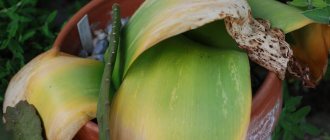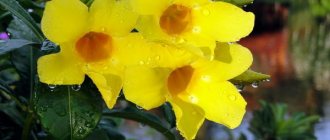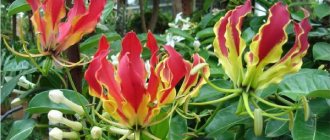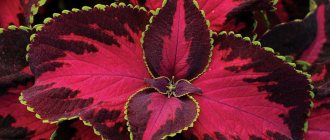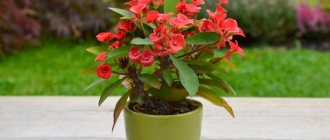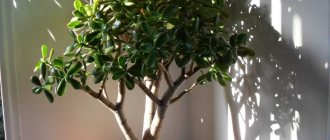This plant is a perennial that is also evergreen. It has creeping shoots, the length of which in most cases reaches one meter. The leaves are simpler and have a broadly lanceolate shape. These leaves can be about 10 cm in length.
On the front side, the leaf has a smooth base of green-violet color, while the back side contains the so-called pubescence.
The flowering period of such a crop begins in April and ends at the end of summer. The flowers are small in size and purple in color. One flower contains three petals, which are the same small inflorescences.
Growing and care at home
Setcreasia culture is often grown as a so-called hanging plant. The plant itself is not very picky, but despite this, care must be carried out according to certain individual rules. We will talk about this and more later in the article.
Illumination
It’s worth noting right away that this culture prefers light, which in turn should be bright, but not contain direct rays of the sun. But despite this, experts recommend exposing this plant to direct sunlight for about three hours. If the light parameter is sufficient for the plant, its leaves will acquire a very beautiful color that will delight its owners. There is an option when netcreasia is grown without the use of solar type light. But in this embodiment, they use 16 hours of light from phytolamps every day.
Important! You must understand that if there is little light, then the foliage of the plant will not be as attractive as you could see in the photo, and the stems will grow much longer, which will lead to failure of flowering.
Temperature
In this case, the lighting factor plays a fundamental role. If the lighting is optimal and it is sufficient for the plant, then you can easily keep the flower at room temperature. But if there is no additional light in the room, then during winter it is necessary to resort to using a cool place where the temperature is from seven to ten degrees. This way the stems will not stretch and they will not lose their color.
How to water?
Watering this plant requires plenty, but in this case it is necessary to take into account that the ground cover should be moist, but not very wet on an ongoing basis.
If you cross the moisture line even a little, the root system of the plant begins to rot. This process accordingly leads to the death of the flower.
It is also important to ensure that the soil is not too dry. Lack of moisture leads to the fact that all components of the flower lose their elasticity. For irrigation, you must use settled water.
Air humidity
In this case, there is a need for increased air humidity, but the flower cannot be sprayed. This is justified by the fact that liquid tends to linger on the foliage, since the foliage is pubescent. Due to this fluid retention, the foliage becomes covered with unsightly spots. In order to increase the humidity in the soil, experts advise placing the flower pot on a pallet on which expanded clay or pebbles are poured. There is a need to place an open container with liquid near the pot.
Important! In winter, this crop should be placed away from devices that heat the air.
Trimming
The process of pruning this plant should be carried out systematically. The crop must be pruned before its active growth begins. And after pruning, the length of the stem should be about 2 cm. If there are still young shoots, then they also need to be systematically pinched.
Fertilizers
The fertilization process is extremely important for any plant. It is necessary to fertilize the soil for this flower once a month. In this case, the fertilizer is used as a universal type. In no case should you give too much fertilizer, since along with the growth of the flower itself, the shoot will also increase, which negatively affects the plant as a whole.
Earth mixture
In this case, there are no special requirements for soil maintenance.
The most important thing is that the substrate has the maximum amount of nutrients. You can purchase a similar mixture of this type of soil at any flower shop. Such soil is called universal in special stores. But it is important to know that such a universal soil should be addressed to indoor plants. Baking powder will be added to such soil.
If you do not want to spend additional money, then you can make such a substrate with your own hands. To do this, you need to mix compost, turf soil and sand. Sometimes experts recommend adding charcoal to this mixture.
It is especially important for this plant variety to ensure the maximum level of drainage. This will eliminate potential waterlogging. As for the potty, you can take the standard type and not worry about anything.
Features of transplantation
First of all, you need to understand that transplantation should be carried out only as needed . As a rule, transplantation is carried out at the beginning of the spring period. In this case, it is necessary to monitor how the root system behaves; if it no longer fits in the pot, then it’s time to transplant the flower into a larger pot.
And this plant grows very quickly, especially regarding its stem. Experts advise keeping this plant only at an early age, because later it no longer brings aesthetic pleasure.
Tradescantia - methods of reproduction
The easiest way to propagate this plant is by cuttings.
In order for the rooting process to take place as efficiently as possible, you can use additional water with soil. You should see the first roots in the shortest possible time, which is a very positive indicator. Experts recommend planting about five cuttings in one immediate pot. In this case, the potential bush will be very lush and beautiful.
Propagation by cuttings
Cuttings of netcreasia photo
Setcreasia propagates very well by apical cuttings, which can be rooted in water or in a peat-sand mixture. To plant the plant you need a small pot; it is better to place several cuttings there at once to make the bush more lush.
The video will tell you how to plant netcreasia from cuttings:
It can also take root by layering and reproduce by seeds. But these methods are used very rarely.
I consider Setcreasia non-toxic - only a small percentage of people can get skin irritation from contact with it.
If you need to be away for a long time (on vacation, business trip), water the netcreasia well, but do not flood it. She will be able to withstand your absence for about a week and a half. If you will be away even longer, it is better to leave the plant on a tray with damp moss or expanded clay.
Diseases and pests
A very pleasant factor is that pests in this case do not touch such a plant. But there are still cases when, for example, a spider mite infects a plant. In order to eliminate it, netcreasia will need to be treated with additional medicine.
The plant is practically not affected by diseases. But if you don’t care for it properly, the roots can dry out, or, on the contrary, rot. In these cases, we are talking about improper watering, about its excess or lack.
Setcreasia purpurea
Setcreasea purpurea, or Tradescantia pallida, is an ornamental plant belonging to the genus Setcreasia, which comes from the Commelinaceae family. Distributed in areas of Eastern Mexico, namely on the border of the Gulf of Mexico.
The perennial evergreen shrub has fleshy creeping stems that are about a meter long. The leaf blades are arranged in regular order and hidden deep in the axils of the shoots. Wide leaves up to 10 cm long appear lanceolate. On the outside, the plates are painted green with a purple tint; on the inside, the color becomes richer, with a short, fleecy coating predominating.
Budding continues from spring until the end of August. The culture blooms in small pinkish inflorescences consisting of 3 petals. The flowers are collected in clusters of several pieces and cover the ends of the shoots.
Magic properties
People have numerous signs associated with indoor plants. Setcreasia is an indicator flower.
If you place it at home, the electrical energy present in the room is instantly determined by the plant.
If a negative environment reigns in the house and a person lives as an energy vampire, the leaves will quickly begin to turn yellow and crumble.
As for envious people, having given them this kind of flower, in a short time it will be possible to notice that envy leaves them.
By using a flower for magical purposes, it is possible to protect yourself from unkind people, since the evil eye loses its power where this plant resides.
Setcreasia purpurea has certain magical properties that are ready to help its owner. The flower protects against love spells, will be able to drive away negative emotions and free you from tense situations.
Kinds
In addition to netcreasia purpurea or otherwise Violet Tradescantia netcreasia, the following are also famous:
- netcreasia striped, growing in tropical areas of America, having creeping, slightly rising shoots;
- setcreasia green, growing in the same America, having climbing, cascading shoots, elongated leaves;
- Tradescantia pallida lives in the swamps of Central and South America. This species is accustomed to moist soil and loves good lighting. Once in home conditions, it easily adapts and grows well even in the shade.
Purple beauty for the home
Setcreasia purpurea can be found in many homes where the owners are fond of home gardening. Caring for it is quite simple, and as a result, the netcreasia flower looks very beautiful, so it can always easily become a decoration for your home interior.
Setcreasia purpurea
Setcreasea purpurea , also called Tradescantia pallida, is directly related to the genus Setcreasia, as well as to the Commelinaceae family. It occurs naturally on the Gulf Coast of Eastern Mexico.
This evergreen perennial has succulent creeping shoots that can reach 1 meter in length. The leaflets are vaginal, alternately arranged. The simple, broadly lanceolate leaves reach approximately 10 centimeters in length. The front side of the foliage is green-purple and smooth, and the back side is purple and has slight pubescence.
It blooms for a very long time from mid-spring to the end of summer. Small pink-violet flowers have 3 wide petals, which are collected in not very large inflorescences at the ends of the stems.
Landing
Planting netcreasia does not require any special skills, so even a novice gardener can cope with it.
Time
Planting is best done in late March to early April when growth potential is highest. If there is a need (the roots have filled the pot or the pot has broken), then replanting can be done at any time of the year - this plant tolerates replanting well throughout any season.
Capacity
Both plastic and ceramic pots are equally suitable for growing this crop. It should be taken into account that in ceramic evaporation will occur faster due to the pores in the material.
You need to make enough drainage holes in the bottom so that excess water comes out freely. The height of the pot should be the same as the width, or slightly wider. It is important to ensure its stability, since after the flower grows it easily tips over.
Substrate
You can purchase soil for indoor decorative foliage crops in the store. It should be nutritious and loose. To increase looseness to the required limit, use vermiculite, perlite or coarse river sand. Any of these ingredients is added in a ratio of 30% to the total volume, after which the soil is thoroughly mixed.
You can make the mixture yourself.
To do this, take the following components:
- turf land;
- compost;
- coarse quartz sand.
All these ingredients are mixed in equal parts, adding a little charcoal to suppress the development of fungal flora.
Landing technique
A 4-5 cm layer of drainage is placed at the bottom of the pot, and soil is poured on top. Then carefully arrange the roots so that they are equally oriented in all directions. The remaining space is filled with soil mixture level with the top of the pot.
Immediately after this, the flower is watered abundantly, and the soil settles a little. It is important to pay attention to ensure that the soil does not remain on the foliage after planting.
